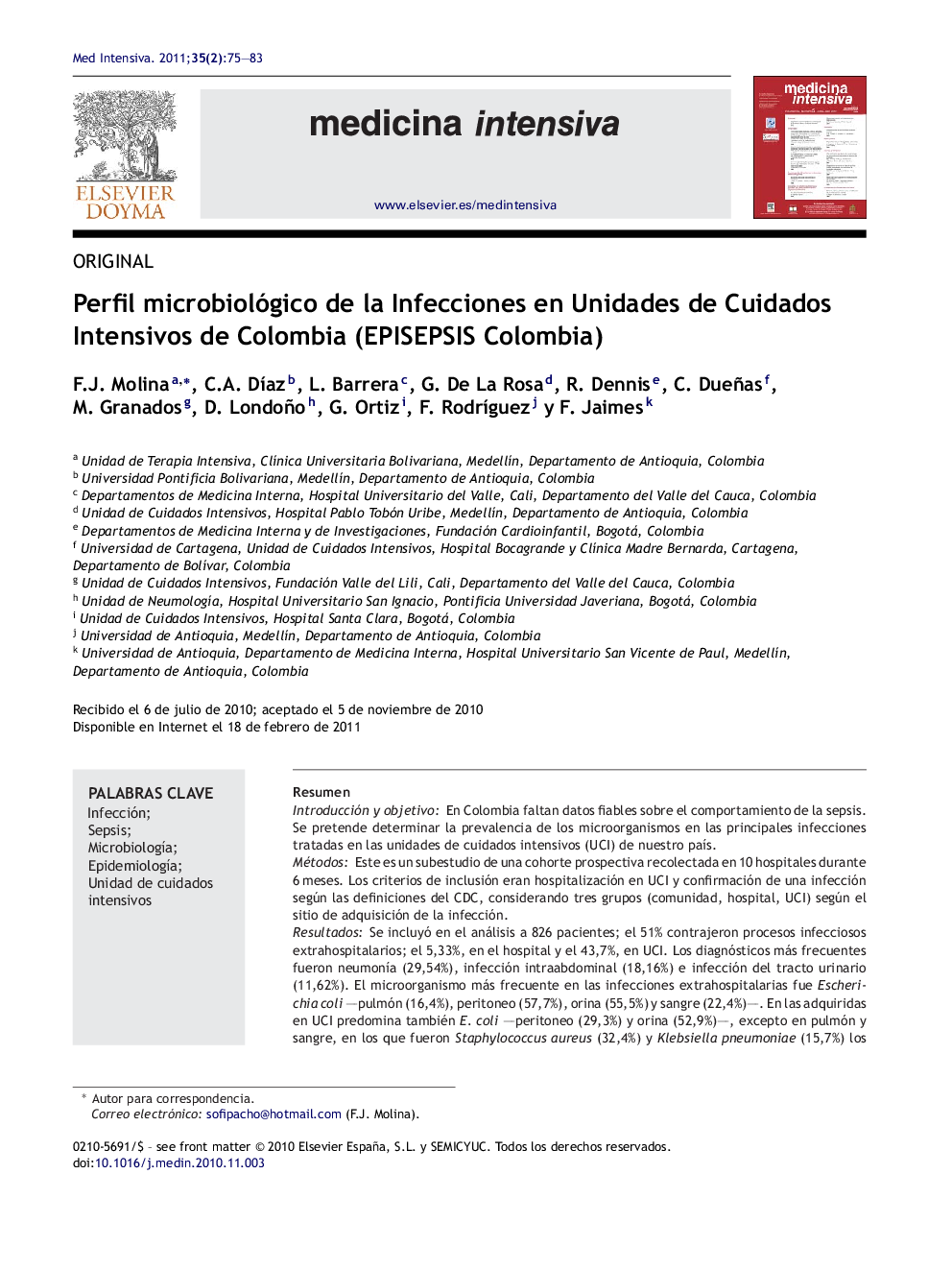| Article ID | Journal | Published Year | Pages | File Type |
|---|---|---|---|---|
| 3113481 | Medicina Intensiva | 2011 | 9 Pages |
ResumenIntroducción y objetivoEn Colombia faltan datos fiables sobre el comportamiento de la sepsis. Se pretende determinar la prevalencia de los microorganismos en las principales infecciones tratadas en las unidades de cuidados intensivos (UCI) de nuestro país.MétodosEste es un subestudio de una cohorte prospectiva recolectada en 10 hospitales durante 6 meses. Los criterios de inclusión eran hospitalización en UCI y confirmación de una infección según las definiciones del CDC, considerando tres grupos (comunidad, hospital, UCI) según el sitio de adquisición de la infección.ResultadosSe incluyó en el análisis a 826 pacientes; el 51% contrajeron procesos infecciosos extrahospitalarios; el 5,33%, en el hospital y el 43,7%, en UCI. Los diagnósticos más frecuentes fueron neumonía (29,54%), infección intraabdominal (18,16%) e infección del tracto urinario (11,62%). El microorganismo más frecuente en las infecciones extrahospitalarias fue Escherichia coli —pulmón (16,4%), peritoneo (57,7%), orina (55,5%) y sangre (22,4%)—. En las adquiridas en UCI predomina también E. coli —peritoneo (29,3%) y orina (52,9%)—, excepto en pulmón y sangre, en los que fueron Staphylococcus aureus (32,4%) y Klebsiella pneumoniae (15,7%) los más prevalentes. Se tomaron cultivos a 655 pacientes, de los que el 40% recibió antibióticos antes de la toma, sin que esto afectara al porcentaje de positividad (p = 0,583).ConclusionesLa neumonía fue la infección más frecuente independientemente del sitio de adquisición. E. coli fue el patógeno más prevalente, excepto en las infecciones pulmonares adquiridas en UCI, donde lo fue S. aureus.
Background and objectiveValid and reliable data regarding sepsis is lacking in Colombia. Our aim was to determine the prevalence of the microorganisms in the main infections treated in Intensive Care Units (ICUs) in our country.MethodsThis is a sub-study of a prospective cohort with 10 general hospitals in Colombia during a 6-month period. The inclusion criteria were hospitalization in ICU and confirmation of infection according to the CDC definitions. Patients were classified into three groups, that is, community, hospital and intensive care, according to the site where the infection was acquired.ResultsA total of 826 patients were included in this analysis. Of these, 51% developed infections in the community, 5.33% in the hospital and 43.7% in intensive care unit. Overall, the most common diagnoses were pneumonia (29.54%), intra-abdominal infection (18.16%) and urinary tract infection (11.62%). The most frequent germ in community-acquired infections was E. coli —lung (16. 4%), peritoneum (57.7%), urine (55.5%), blood (22.4%)—. E. coli —peritoneum (29.3%), urine (52.9%)— also predominated in the ICU-acquired infections, except for lung and blood in which Staphylococcus aureus (32.4%) and Klebsiella pneumoniae (15.7%) were the most prevalent. Cultures were requested from 655 patients, 40% of them having received antibiotics before cultures were taken, although this did not affected the percentages of positive cultures (P = 0.583).ConclusionsPneumonia was the main cause of infection regardless of the site of acquisition. E. coli was the most prevalent germ, except in the pulmonary infections acquired in UCI in which S. aureus was the most prevalent.
